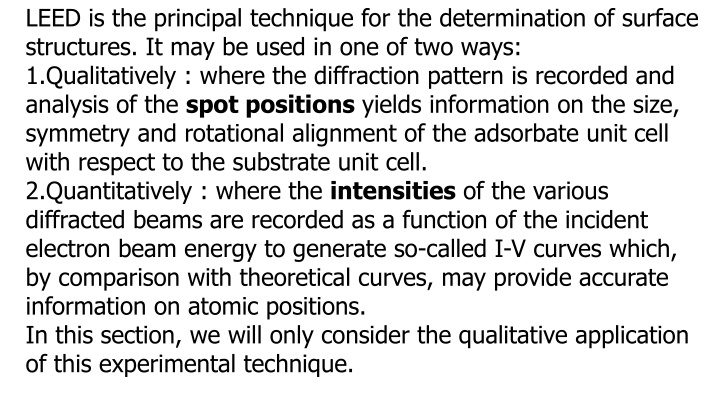
LEED: Qualitative Surface Structure Determination
Learn about LEED, the principal technique for determining surface structures qualitatively. Discover how diffraction patterns are analyzed to provide insights into size, symmetry, and alignment of adsorbate unit cells on substrates, utilizing a well-ordered single crystal sample and back-scattered electron diffraction patterns.
Uploaded on | 3 Views
Download Presentation

Please find below an Image/Link to download the presentation.
The content on the website is provided AS IS for your information and personal use only. It may not be sold, licensed, or shared on other websites without obtaining consent from the author. If you encounter any issues during the download, it is possible that the publisher has removed the file from their server.
You are allowed to download the files provided on this website for personal or commercial use, subject to the condition that they are used lawfully. All files are the property of their respective owners.
The content on the website is provided AS IS for your information and personal use only. It may not be sold, licensed, or shared on other websites without obtaining consent from the author.
E N D
Presentation Transcript
LEED is the principal technique for the determination of surface structures. It may be used in one of two ways: 1.Qualitatively : where the diffraction pattern is recorded and analysis of the spot positions yields information on the size, symmetry and rotational alignment of the adsorbate unit cell with respect to the substrate unit cell. 2.Quantitatively : where the intensities of the various diffracted beams are recorded as a function of the incident electron beam energy to generate so-called I-V curves which, by comparison with theoretical curves, may provide accurate information on atomic positions. In this section, we will only consider the qualitative application of this experimental technique.
The LEED experiment uses a beam of electrons of a well-defined low energy (typically in the range 20 - 200 eV) incident normally on the sample. The sample itself must be a single crystal with a well-ordered surface structure in order to generate a back-scattered electron diffraction pattern. A typical experimental set-up is shown below. Only the elastically-scattered electrons contribute to the diffraction pattern ; the lower energy (secondary) electrons are removed by energy- filtering grids placed in front of the fluorescent screen that is employed to display the pattern.
Basic Theory of LEED By the principles of wave-particle duality, the beam of electrons may be equally regarded as a succession of electron waves incident normally on the sample. These waves will be scattered by regions of high localised electron density, i.e. the surface atoms, which can therefore be considered to act as point scatterers. The wavelength of the electrons is given be the de Broglie relation: =h/p wavelength and electron momentum P = mv = (2mEK)1/2 = (2meV)1/2 = h/(2meV)1/2
From the above examples the range of wavelengths of electrons employed in LEED experiments is seen to be comparable with atomic spacings, which is the necessary condition for diffraction effects associated with atomic structure to be observed. Consider, first, a one dimensional (1-D) chain of atoms (with atomic separation a ) with the electron beam incident at right angles to the chain. This is the simplest possible model for the scattering of electrons by the atoms in the topmost layer of a solid; in which case the diagram below would be representing the solid in cross-section with the electron beam incident normal to the surface from the vacuum above.
If you consider the backscattering of a wavefront from two adjacent atoms at a well-defined angle, , to the surface normal then it is clear that there is a "path difference" (d) in the distance the radiation has to travel from the scattering centres to a distant detector (which is effectively at infinity) - this path difference is best illustrated by considering two "ray paths" such as the right-hand pair of green traces in the above diagram. The size of this path difference is a sin and this must be equal to an integral number of wavelengths for constructive interference to occur when thescattered beams eventually meet and interfere at the detector i.e. d = a sin = n is satisfied exactly. The diagram below shows a typical intensity profile for this case.
There are a number of points worth noting from this simple 1-D model 1.the pattern is symmetric about = 0 (or sin = 0) 2.sin is proportional to 1 / V1/2(since is proportional to 1 / V1/2) 3.sin is inversely proportional to the lattice parameter , a The aforementioned points are in fact much more general - all surface diffraction patterns show a symmetry reflecting that of the surface structure, are centrally symmetric, and of a scale showing an inverse relationship to both the square root of the electron energy and the size of the surface unit cell. As an example we can look at the LEED pattern from an fcc (110) surface. In the diagram below the surface atomic structure is shown on the left in plan view, as if you are viewing it from the position of the electron gun in the LEED experiment (albeit greatly magnified). The primary electron beam would then be incident normally on this surface as if fired from your current viewpoint and the diffracted beams would be scattered from the surface back towards yourself. The diffraction pattern on the right illustrates how these diffracted beams would impact upon the fluorescent screen.
The pattern shows the same rectangular symmetry as the substrate surface but is "stretched" in the opposite sense to the real space structure due to the reciprocal dependence upon the lattice parameter. The pattern is also centrosymmetric about the (00) beam - this is the central spot in the diffraction pattern corresponding to the beam that is diffracted back exactly normal to the surface (i.e. the n = 0 case in our 1-D model). The above illustration of the diffraction pattern shows only the "first-order" beams i.e. it is representative of the diffraction pattern visible at low energies when only for n = 1 is the angle of diffraction, , sufficiently small for the diffracted beam to be incident on the display screen. By contrast, the diagram below shows the diffraction pattern that might be expected if the energy of the incident electrons is doubled - some of the second order spots are now visible and the pattern as a whole has apparently contracted in towards the central (00) spot.
from satisfactory method of explaining LEED patterns from surfaces. A much better method of looking at LEED diffraction patterns involves using the concept of reciprocal space: more specifically , it can be readily shown that - " The observed LEED pattern is a (scaled) representation of the reciprocal net of the pseudo-2D surface structure " The reciprocal net is determined by (defined by) the reciprocal vectors : a1* & a2* (for the substrate) and b1* & b2* (for the adsorbate) Initially we will consider just the substrate. The reciprocal vectors are related to the real space unit cell vectors by the scalar product relations : a1. a2* = a1* . a2= 0 and a1. a1* = a2. a2* = 1 For those not too keen on vector algebra these mean that : a1is perpendicular to a2* , and a2is perpendicular to a1* there is an inverse relationship between the lengths of a1and a1* (and a2and a2* ) of the form : |a1| = 1 / ( |a1*| cos A ) , where A is the angle between the vectors a1and a1*. Note : when A = 0 degrees (cos A = 1) this simplifies to a simple reciprocal relationship between the lengths a1and a1*. Exactly analogous relations hold for the real space and reciprocal vectors of the adsorbate overlayer structure : b1, b1* , b2and b2* . To a first approximation, the LEED pattern for a given surface structure may be obtained by superimposing the reciprocal net of the adsorbate overlayer (generated from b1* and b2* ) on the reciprocal net of the substrate (generated from a1* and a2* )
Let us now look at an example - the diagram below shows an fcc(100) surface (again in plan view) and its corresponding diffraction pattern (i.e. the reciprocal net) .
We can demonstrate how these reciprocal vectors can be determined by working through the problem in a parallel fashion for the two vectors :


















